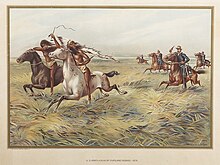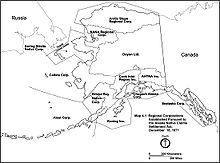Aboriginal title in the United States
Native American tribes and nations establish aboriginal title by actual, continuous, and exclusive use and occupancy for a "long time."
Many potentially meritorious tribal lawsuits have been settled by Congressional legislation providing for the extinguishment of aboriginal title as well as monetary compensation or the approval of gaming and gambling enterprises.
Fletcher v. Peck (1810) and Johnson v. McIntosh (1823), the first and the most detailed explorations of the subject by Marshall, respectively, both arose out of collusive lawsuits, where land speculators deceived the court with a falsified case and controversy in order to elicit the desired precedent.
The Indian Removal Act of 1830 established policy that resulted in the complete extinguishment of aboriginal title in Alabama and Mississippi (1832); Florida and Illinois (1833); Georgia, North Carolina, and Tennessee (1835) [the Treaty of New Echota]; Indiana (1840); and Ohio (1842).
[4] This shift in policy resulted in all tribal lands being either ceded to the federal government or designated as an Indian reservation in Iowa, Minnesota, Texas, and Kansas by 1870; Idaho, Washington, Utah, Oregon, Nevada, Wyoming, Nebraska, and Colorado by 1880; and Montana, Arizona, and New Mexico by 1886.
"[7] In 1887, the Dawes Act introduced an allotment policy, whereby communal reservation lands were divided into parcels held in fee simple (and thus alienable) by individual Indians, with the "surplus," as declared by the government, sold to non-Indians.
3 provides: [The Congress shall have Power] To regulate Commerce with foreign Nations, and among the several States, and with the Indian tribes;Relevant federal statutes include: N.Y. Const.
The test for the acknowledgement of aboriginal title in the United States is actual, exclusive and continuous use and occupancy for a "long time".
[12] Unlike nearly all common law jurisdictions, the United States acknowledges that aboriginal title may be acquired post-sovereignty; a "long time" can mean as little as 30 years.
[15] 'Cramer v. United States' (1923) was the first Supreme Court decision to acknowledge the doctrine of individual aboriginal title, not held in common by tribes.
[29][30][31][32] Even fraud will not void the extinguishment of aboriginal title by the federal government (or by any actor, if the tribe waives the issue in the lower court).
[15] Extinguishment retroactively validates trespasses and removals of resources from aboriginal lands, and thus bars compensation (either statutory or constitutional) for those encroachments.
[38] The infamous Lone Wolf v. Hitchcock (1903) held that Congress's power to extinguish was plenary, notwithstanding Indian treaties to the contrary.
[53] Indian removal policy resulted in the complete extinguishment of aboriginal title in Alabama and Mississippi (1832), Florida and Illinois (1833), Georgia, North Carolina, and Tennessee (1835) [the Treaty of New Echota], Indiana (1840), and Ohio (1842).
Most Spanish residents in the state failed to inform the tribal members of their rights to claim land, or had already driven most of the Mission Indians into the Sierras.
[73] The federal navigable servitude also bars the assertion of aboriginal title, although this may give rise to a claim for breach of fiduciary duty under the ICCA.
[74] Aboriginal title is absolutely extinguished to offshore submerged lands in the Outer Continental Shelf, however, under the doctrine of paramountcy.
[77] For the first 100 years of the history of the United States, the doctrine of aboriginal title existed only in dicta supplied by decisions concerning land disputes between non-indigenous parties.
[78] Seneca Nation of Indians v. Christy (1896), the first aboriginal title claim by an indigenous plaintiff to reach the U.S. Supreme Court, typifies the state of the law up until that point, and largely until the 1970s.
[97] According to the Ninth Circuit in Miller v. United States (1947), Tillamooks I held that even unrecognized aboriginal title is property under the Fifth Amendment, the extinguishment of which requires just compensation.
[98] Although the issue was not raised in the case, a footnote in Hynes v. Grimes Packing (1949) repudiated the 9th Circuit view and insisted that aboriginal title was non-compensable.
[100] Tee-Hit-Ton Indians v. United States (1955) finally held that unrecognized aboriginal title was not property within the meaning of the Fifth Amendment, and thus could be extinguished without compensation.
[118] Recovery is limited to that fair market value, and may not be increased to another measure, such as restitution of the profit gained by the United States through breaching its duty.
The federal government has consented to some compensatory suits under the Indian Claims Commission Act, supra, subject to a statute of limitations.
[125] Although Coeur d'Alene involved sovereign title to a lake bed, this precedent has been applied to bar even suits against states in their capacity as ordinary property owners.
§ 1362, providing: "district courts shall have original jurisdiction of all civil actions, brought by any Indian tribe or band with a governing body duly recognized by the Secretary of the Interior, wherein the matter in controversy arises under the Constitution, laws, or treaties of the United States.
[133] This holding has subsequently been expanded to nearly all of Congress's Article One powers,[134] leaving only the Reconstruction Amendments as a basis for abrogating state sovereign immunity.
"[81] A footnote in the majority also quoted Ewert v. Bluejacket (1922),[141] which held that laches "cannot properly have application to give vitality to a void deed and to bar the rights of Indian wards in lands subject to statutory restrictions.
"[81] City of Sherrill v. Oneida Indian Nation of N.Y. (2005) applied laches to an attempt to revive tribal sovereignty over land reacquired by the tribe in fee simple.
The Third, Sixth, Eighth, and Tenth Circuits, since Sherrill, have declined to reach the question of the scope of laches as a defense to ancient tribal claims.







